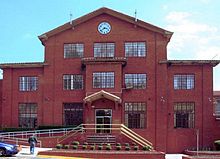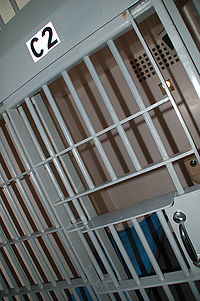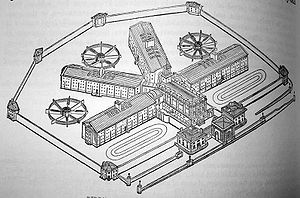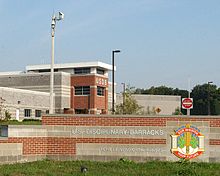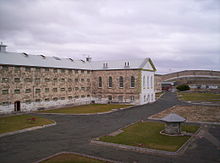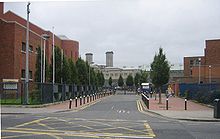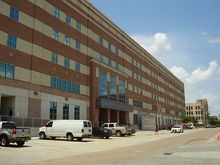- Prison
-
"Jail" and "Gaol" redirect here. For other uses, see Jail (disambiguation).For other uses, see Prison (disambiguation).
A prison (from Old French prisoun)[1] is a place in which people are physically confined and, usually, deprived of a range of personal freedoms. Imprisonment or incarceration is a legal penalty that may be imposed by the state for the commission of a crime. Other terms are penitentiary, penalty school, correctional facility, remand centre, detention centre, gaol, and jail.
A criminal suspect who has been charged with or is likely to be charged with criminal offense may be held on remand in prison if he is denied or unable to meet conditions of bail, or is unable or unwilling to post bail. A criminal defendant may also be held in prison while awaiting trial or a trial verdict. If found guilty, a defendant will be convicted and may receive a custodial sentence requiring imprisonment.
As well as convicted or suspected criminals, prisons may be used for internment of those not charged with a crime. Prisons may also be used as a tool of political repression to detain political prisoners, prisoners of conscience, and "enemies of the state", particularly by authoritarian regimes. In times of war or conflict, prisoners of war may also be detained in prisons. A prison system is the organizational arrangement of the provision and operation of prisons.
Contents
History
For most of history, imprisoning has not been a punishment in itself, but rather a way to confine criminals until corporal or capital punishment was administered. There were prisons used for detention in Jerusalem in Old Testament times, and the Bible details the imprisonment of Joseph in Egypt.[2] Dungeons were used to hold prisoners; those who were not killed or left to die there often became galley slaves or faced penal transportations. In other cases debtors were often thrown into debtor's prisons, until they paid their jailers enough money in exchange for a limited degree of freedom.
Only in the 19th century, beginning in Britain, did prisons as known today become commonplace. The modern prisons system was born in London, influenced by the utilitarianism of Jeremy Bentham. Bentham's panopticon introduced the principle of observation and control that underpins the design of the modern prison. The notion of prisoners being incarcerated as part of their punishment and not simply as a holding state until trial or hanging, was at the time revolutionary. This is when prisons had begun to be used as criminal rehabilitation centers.
Britain practiced penal transportation of convicted criminals to penal colony in the British colonies in the Americas, from the 1610s through the American Revolution in the 1770s and to penal colonies in Australia between 1788 and 1868. France sent criminals to tropical penal colonies including Louisiana in the early 18th century.[3] Penal colonies in French Guiana operated until 1951 (in particular, infamous Île du Diable (Devil's Island)). Katorga prisons were established in the 17th century in Tsardom of Russia in underpopulated areas of Siberia and the Russian Far East that had few towns or food sources. Since these times, Siberia gained its fearful connotation of punishment.
Design and facilities
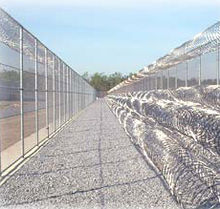 Barbed tape is a feature of prisons.
Barbed tape is a feature of prisons.
Male and female prisoners are typically kept in separate locations or separate prisons altogether.[4] Prison accommodation, especially modern prisons in the developed world, are often divided into wings. A building holding more than one wing is known as a "hall". Many prisons are divided into two sections, one containing prisoners before trial and the other containing convicted prisoners.
Facilities
Amongst the facilities that prisons may have are:
- A main entrance, which may be known as the 'sally port' or 'gatelodge' (stemming from old castle nomenclature)
- A religious facility, which will often house chaplaincy offices and facilities for counselling of individuals or groups
- An 'education facility', often including a library, providing adult education or continuing education opportunities
- A gym or an exercise yard, a fenced, usually open-air-area which prisoners may use for recreational and exercise purposes
- A healthcare facility or hospital
- A segregation unit (also called a 'block' or 'isolation cell'), used to separate unruly, dangerous, or vulnerable prisoners from the general population, also sometimes used as punishment (see solitary confinement)
- A section of vulnerable prisoners (VPs), or protective custody (PC) units, used to accommodate prisoners classified as vulnerable, such as sex offenders, former police officers, informants and those that have gotten into debt or trouble with other prisoners
- A section of safe cells, used to keep prisoners under constant visual observation, for example when considered at risk of suicide
- A visiting area, where prisoners may be allowed restricted contact with relatives, friends, lawyers, or other people
- A death row in some prisons, a section for criminals awaiting execution
- A staff accommodation area, where staff and prison officers live in the prison, typical of historical prisons
- A service/facilities area housing support facilities like kitchens
- Industrial or agricultural plants operated with convict labour
- A recreational area containing items such as a TV and pool table
Prison design
Prisons are normally surrounded by fencing, walls, earthworks, geographical features, or other barriers to prevent escape. Multiple barriers, concertina wire, electrified fencing, secured and defensible main gates, armed guard towers, lighting, motion sensors, dogs and roving patrols may all also be present depending on the level of security. Remotely controlled doors, CCTV monitoring, alarms, cages, restraints, nonlethal and lethal weapons, riot-control gear and physical segregation of units and prisoners may all also be present within a prison to monitor and control the movement and activity of prisoners within the facility.
Modern prison designs have sought to increasingly restrict and control the movement of prisoners throughout the facility while permitting a maximal degree of direct monitoring by a smaller prison staff. As compared to traditional large landing-cellblock designs which were inherited from the 19th century and which permitted only intermittent observation of prisoners, many newer prisons are designed in a decentralized "podular" layout.
Smaller, separate and self-contained housing units known as "pods" or "modules" are designed to hold between sixteen and fifty prisoners each and are arranged around exercise yards or support facilities in a decentralized "campus" pattern. A small number of prison officers, sometimes a single officer, is assigned to supervise each pod. The pods contain tiers of cells arranged around a central control station or desk from which a single officer can monitor all of the cells and the entire pod, control cell doors and communicate with the rest of the prison. Pods may be designed for high-security "indirect-supervision", in which officers in segregated and sealed control booths monitor smaller numbers of prisoners confined to their cells.
An alternative is "direct-supervision", in which officers work within the pod and directly interact with and supervise prisoners, who may spend the day outside their cells in a central "dayroom" on the floor of the pod. Movement in or out of the pod to and from exercise yards, work assignments or medical appointments can be restricted to individual pods at designated times and is generally centrally controlled. Goods and services, such as meals, laundry, commissary, educational materials, religious services and medical care can increasingly be brought to individual pods or cells as well.
Despite these design innovations, overcrowding at many prisons, particularly in the U.S., has resulted in a contrary trend, as many prisons are forced to house large numbers of prisoners, often hundreds at a time, in gymnasiums or other large buildings that have been converted into massive open dormitories. Lower-security prisons are often designed with less restrictive features, confining prisoners at night in smaller locked dormitories or even cottage or cabin-like housing while permitting them freer movement around the grounds to work or activities during the day.
Security levels
The levels of security within a prison system are categorized differently around the world, but tend to follow a distinct pattern. Most developed countries divide prisons into separate security classes depending on the inmate population and the security needed to keep them under control. Accordingly, most developed countries have classes ranging from the most secure, which typically hold violent prisoners and those judged most likely to escape, to the least, which are most often used to house non-violent offenders or those for whom more stringent security is deemed unnecessary. Below are some different examples of prison classifications from around the world.
England and Wales
Main article: Prison security categories in the United KingdomIn England and Wales, prisoners are assigned security classes when they are sentenced. Thus prisons are given security classifications depending on the prisoners they are designed to hold. Therefore, prisons classified as "A" would typically house prisoners assigned the "A" category during sentencing, and be designed with the level of security necessary for that class. The categories of prisoners in descending order are:
- Category A: prisoners are those whose escape would be highly dangerous to the public or national security.
- Category B: prisoners are those who do not require maximum security, but for whom escape needs to be made very difficult.
- Category C: prisoners are those who cannot be trusted in open conditions but who are unlikely to try to escape.
- Category D: prisoners are those who can be reasonably trusted not to try to escape, and are given the privilege of an open prison. Prisoners at 'D Cat' (as it is commonly known) prisons, are, subject to approval, given ROTL (Release On Temporary Licence) to work in the community or to go on 'home leave' once they have passed their FLED (Full Licence Eligibility Dates), which is usually a quarter of the way through the sentence.
The British prison system is also divided into "Open" and "Closed" prisons. Categories A-C are considered "Closed" prisons as prisoners cannot be trusted to interact with society, while category D prisons are generally "Open", meaning that prisoners with a good record and who are approved can be allowed limited function in society such as home-leave or a nominal employment.
United States
In the United States, "jail" and "prison" refer to separate levels of incarceration; generally speaking, jails are county or city administrated institutions which house both inmates awaiting trial on the local level and convicted misdemeanants serving a term of one year or less, while prisons are state or federal facilities housing convicted felons serving a term of more than one year. On the federal level, this terminology has been largely superseded by a more complex five-tier system implemented by the Federal Bureau of Prisons that ranges from low security "Prison Camps" to medium security "Correctional Institutions" and finally maximum security "Penitentiaries". Federal prisons can also house pre-trial inmates.[6]
 ADX Florence is presently the only facility housing supermax units operating in the Federal Bureau of Prisons.
ADX Florence is presently the only facility housing supermax units operating in the Federal Bureau of Prisons.
The exact classification systems differ between county, state, and federal systems. Some common types of prisons include:
- Supermax: As the name implies, the custody level goes beyond Maximum by segregating "the worst of the worst" in a prison system, such as terrorists deemed a threat to national security and inmates from other prisons who have a history of violent behavior. This level is also used for non-terrorists who have been deemed too dangerous or too high-profile to ever be in a normal prison. These inmates have individual cells and are kept in lockdown for 23 hours per day. Meals are served through "chuck holes" in the cell door, and each inmate is permitted out of their cell for one hour of exercise per day, alone. They are permitted no contact with other inmates and are under constant surveillance via closed-circuit television cameras.
- Administrative: Administrative security is a classification of prisons or detention centers that are for a specific purpose, such as housing mentally ill offenders. These range in levels of security from Minimum to Administrative Maximum Security (ADMAX), as in the case of ADX Florence in Colorado.
- Maximum: A custody level in which both design and construction as well as inmate classification reflect the need to provide maximum external and internal control and supervision of inmates primarily through the use of high security perimeters and extensive use of internal physical barriers and check points. Inmates accorded this status present serious escape risks or pose serious threats to themselves, to other inmates, to staff, or the orderly running of the institution. Supervision of inmates is direct and constant.
- High: The "Middle Ground" for violent crimes, High security institutions have highly-secured perimeters (featuring walls or reinforced fences), multiple- and single-occupant cell housing, the highest staff-to-inmate ratio, and close control of inmate movement.
- Medium: A custody level in which design and construction as well as inmate classification reflect the need to provide secure external and internal control and supervision of inmates. Inmates accorded to this status may present a moderate escape risk or may pose a threat to other inmates, staff, or the orderly running of the institution. Supervision remains constant and direct. Through an inmate's willingness to comply with institutional rules and regulations, increased job and program opportunities exist.
- Close Security: Close Security prisons are institutions which house inmates too dangerous for Low Security, but who did not commit a crime worthy of incarceration in a Medium Security Facility. These prisons are rare, as most inmates fall into either "Medium" or "Low" Security Classifications. These facilities are often located in separate areas of a Low or Medium security Prison.
- Low: A custody level in which both the design and construction as well as inmate classification reflect the goal of returning to the inmate a greater sense of personal responsibility and autonomy while still providing for supervision and monitoring of behavior and activity. Inmates within this security level are not considered a serious risk to the safety of staff, inmates or to the public. Program participation is mandated and geared toward their potential reintegration into the community. Additional access to the community is limited and under constant direct staff supervision
- Minimum: The lowest level of security to which an inmate can be assigned directly. This type of prison is typically a "prison farm", or other work-oriented facility, and most often houses petty or "white collar" criminals.
- Pre-release. A custody level in which both design and construction as well as inmate classification reflect the goal of restoring to the inmate maximum responsibility and control of their own behavior and actions prior to their release. Direct supervision of these inmates is not required, but intermittent observation may be appropriate under certain conditions. Inmates within this level may be permitted to access the community unescorted to participate in programming, including but not limited to work release or educational release.
Special types of prison
Juvenile
Main article: Youth detention centerPrisons for juveniles (people under 17 or 18, depending on the jurisdiction) are known as young offender facilities or similar designation and hold minors who have been remanded into custody or serving sentence. Many countries have their own age of criminal responsibility in which children are deemed legally responsible for their actions for a crime. Countries such as Canada may try to sentence a juvenile as an adult, but have them serve their sentence in a juvenile facility until they reach the age of majority, at which time they would be transferred to an adult facility.
Military
Main article: Military prisonPrisons form part of military systems, and are used variously to house prisoners of war, unlawful combatants, those whose freedom is deemed a national security risk by military or civilian authorities, and members of the military found guilty of a serious crime.
Political
Main article: Political prisonerCertain countries maintain or have in the past had a system of political prisons; arguably the gulags associated with Stalinism are best known.
Psychiatric
Main article: Psychiatric hospitalSome psychiatric facilities have characteristics of prisons, particularly when confining patients who have committed a crime and are considered dangerous. In addition, many prisons have psychiatric units dedicated to housing offenders diagnosed with a wide variety of mental disorders.
Countries
Asia and Oceania
Australia
Further information: List of Australian prisons, Immigration detention centres, and Mandatory detention in AustraliaMany prisons in Australia were built by convict labour in the 19th century. During the 1990s, various state governments in Australia engaged private sector correctional corporations to build and operate prisons whilst several older government run institutions were decommissioned. Operation of Federal detention centres was also privatised at a time when asylum seekers began to be mandatorily detained in Australia.
China
Further information: LaogaiChina's prison population is estimated at about 2 million.[7]
Japan
Further information: Penal system of JapanNew Zealand
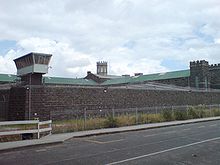 Mount Eden Prison is a 19th-century brick stockade located just south of the Auckland CBD, a very populous (and affluent) neighbourhood of Mt Eden in Auckland, New Zealand.
Mount Eden Prison is a 19th-century brick stockade located just south of the Auckland CBD, a very populous (and affluent) neighbourhood of Mt Eden in Auckland, New Zealand. Further information: Department of Corrections (New Zealand) and List of correctional facilities in New Zealand
Further information: Department of Corrections (New Zealand) and List of correctional facilities in New ZealandNew Zealand currently maintains 19 prisons around the country. The Department of Corrections has an annual budget of NZD$748 million and assets worth over NZD$1.7 billion. Official statistics show (as of June 30, 2007) that there are currently 7,605 prisoners within the New Zealand correctional system. (5,490 Sentenced Prisoners and 1,552 Remanded Prisoners) + 5,795 staff. Breakouts are only at 0.15 per 100 prisoners and there is a rate of only 15% positive drug results during random drug testing in NZ prisons.[8]
Europe
Estonia
Main article: Prisons in EstoniaEstonia currently maintains five prisons around the country: Harku Prison, Murru Prison, Tallinn Prison, Tartu Prison and Viru Prison.[9] In March 2011, there were 3,405 persons incarcerated in Estonia, and the number of prisoners per 100,000 residents were 254, which is the third highest rate in the EU. These figures include pre-trial detainees and remand prisoners.[10][11] It is, however, a much lower rate than in the late 1990s and early 2000s, when the Estonian prison population reached almost 5,000 persons.[10]
Finland
Finland has 26 prisons (of which about half are open institutions). Official statistics showed on average 3500 places (2003).
France
The French Ministry of Justice's French Prison Service division has 194 prisons in mainland and the overseas territories. As of 1 January 2009, statistics showed approximately 52,000 available places, with around 58,000 "hosted" prisoners.[12] France is home to Fleury-Mérogis Prison, Europe's largest correctional facility.
Germany
Main article: Prisons in GermanyGermany has 194 prisons (of which 19 are open institutions). Official statistics showed 80,214 places on March 31, 2007. On the same day, there were 75,719 prisoners (of which 13,168 pre-trial; 60,619 serving sentences; 1,932 others, i.e. mainly civil prisoners; 4,068 were female). This is less than the highest value of 81,176 prisoners on March 31, 2003.[13][14]
Ireland
Main article: Prisons in IrelandThere are currently 14 prisons operating in the Republic of Ireland with a total bed capacity of 4,106 as of the 31 December 2009. The daily average number of prisoners in custody in 2009 was 3,881. However, most of these prisons currently operate at or above capacity.[15]
Norway
Main article: Prisons in NorwayPrisoners in Norway are assigned to prison cells of various categories: Cells used by prisoners in police custody most often belong to category glattcelle ("smooth"+"cell").[16] The police force of Oslo was fined Norwegian kroner 50 000 in 2011 for holding a prisoner for 8 days in a glattcelle (And for a similar[17] incident later in 2011, the police district was not fined because it had already been fined for the first incident).
Ombudsman for Children in Norway claims that a United Nations' committee has criticized practices in regard to the imprisonment of children in Norway.[18]
Poland
As of the end of August 2007, Poland officially declared 90,199 prisoners (13,374 pre-trial; 76,434 serving sentences; 391 others; 2,743 prisoners were female), giving an imprisonment rate per 100,000 inhabitants of about 234. The overpopulation rate (number of prisoners held compared to number of places for prisoners) was estimated by the official prison service as 119%.[19]
The growth rate of imprisonment in Poland during 2006–2007 was approximately 4% annually, based on the August 2007 estimate of 90,199 prisoners and the June 2005 estimate of 82,572 prisoners.[20]
Turkey
Main article: Prisons in TurkeyPrisons in Turkey are classified as closed, semi-open and open prisons. Closed prisons are separated into different kinds according to its structure and the number of prisoners held. Examples are A type, B type, E type and F type. F types are high security prisons, known in the United States as Supermax.
United Kingdom
Main article: Her Majesty's Prison ServiceMain article: Northern Ireland Prison ServiceMain article: Scottish Prison ServiceSee also: United Kingdom prison populationIn the Prison Act 1952, the word "prison" does not include a naval, military or air force prison.[21]
In section 38B of the Criminal Law Act 1977, the word "prison" means, in the case of a person who is under the age of 21 years arrested in England and Wales, any place in which he could be detained under section 12(10) of the Criminal Justice Act 1982, and, in the case of a person under that age arrested in Northern Ireland, a young offenders centre.[22]
In section 1 of the Prison Security Act 1992, the word "prison" means any prison, young offender institution or remand centre which is under the general superintendence of, or is provided by, the Secretary of State under the Prison Act 1952, including a contracted out prison within the meaning of Part IV of the Criminal Justice Act 1991[23]
In section 4 of the Regulation of Investigatory Powers Act 2000, the word "prison" means any prison, young offender institution, young offenders centre or remand centre which is under the general superintendence of, or is provided by, the Secretary of State under the Prison Act 1952 or the Prison Act (Northern Ireland) 1953, or, any prison, young offenders institution or remand centre which is under the general superintendence of the Scottish Ministers under the Prisons (Scotland) Act 1989, and includes any contracted out prison, within the meaning of Part IV of the Criminal Justice Act 1991 or section 106(4) of the Criminal Justice and Public Order Act 1994, and any legalised police cells within the meaning of section 14 of the Prisons (Scotland) Act 1989.[24]
North America
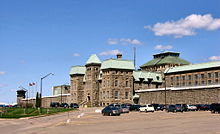 Dorchester Penitentiary in New Brunswick, Canada, part of Corrections Canada. Opened in 1880 as a maximum security prison, it now functions as a medium security facility.
Dorchester Penitentiary in New Brunswick, Canada, part of Corrections Canada. Opened in 1880 as a maximum security prison, it now functions as a medium security facility.
Canada
The 52 penitentiaries in Canada are operated by the federal government, and are for those who have been sentenced to serve more than 2 years of custody. The boundary of two years separating provincial and federal custody underlies the sentencing of some offenders to "two years less a day", so they can serve their sentences in provincial correctional institutions.
Jamaica
Further information: Prisons in JamaicaUnited States
The 1200 Jail in Downtown Houston, Texas, serves as a jail and the headquarters of the Harris County Sheriff's Office. Further information: Incarceration in the United StatesSee also: Federal Bureau of Prisons
Further information: Incarceration in the United StatesSee also: Federal Bureau of PrisonsIn the United States penal system, a jail is a facility used to detain persons who are in the lawful custody of the state, including accused persons awaiting trial and those who have been convicted of a crime and are serving a sentence of less than one year.[25][26] Jails are generally small prisons run by individual counties and cities,[26] though some jails in larger communities may be as large and hold as many inmates as regular prisons. As with prisons, some jails have different wings for certain types of offenders, and have work programs for inmates who demonstrate good behavior.
Approximately half of the U.S. jail population consists of pretrial detainees who have not been convicted or sentenced. Prisoners serving terms longer than one year are typically housed in prison facilities operated by state governments.[27] Unlike most state prisons, a jail usually houses both men and women in separate portions of the same facility. Some jails lease space to house inmates from the federal government, state prisons or other counties as a revenue-raising method.
In 2005, a report by the Bureau of Justice Statistics found that 62 percent of people in jails have not been convicted, and are awaiting trial.[28] As of 2005[update], local jails held or supervised 819,434 individuals. Nine percent of these individuals were in programs such as community service, work release, weekend reporting, electronic monitoring, and other alternative programs.[26]
South America
Brazil
Further information: Crime in BrazilIn 2010, 473,600 people were incarcerated in Brazilian prisons and jails.[29]
Peru
Further information: National Penitentiary Institute (Peru)Population statistics
See also: List of countries by incarceration rateAs of 2006, it is estimated that at least 9.25 million people are currently imprisoned worldwide.[30] It is probable that this number is much higher, in view of general under-reporting and a lack of data from various countries, especially authoritarian regimes.
See also
References
- ^ Online Etymology Dictionary, retrieved on 2009-10-12.
- ^
 "Prisons". Catholic Encyclopedia. New York: Robert Appleton Company. 1913.
"Prisons". Catholic Encyclopedia. New York: Robert Appleton Company. 1913. - ^ Taylor, Alan. American Colonies. Penguin: London(2001).
- ^ International Profile of Women's Prisons (144p), International Centre for Prison Studies, April 2008
- ^ Report of the Surveyor-General of Prisons, London, 1844 reproduced in Mayhew, Criminal Prisons of London, London, 1862
- ^ "BOP Information". BOP. http://www.bop.gov/inmate_locator/index.jsp.
- ^ "China torture 'still widespread'". BBC News. December 2, 2005.
- ^ Corrections Department NZ - Facts and statistics.
- ^ Prisons of Estonia Vangide arv Eestis 1991-2005 ja selle vähendamise karistusõiguslikud ja kriminoloogilised alused.
- ^ a b International Centre for Prison Studies: Estonia Retrieved 2011-07-29
- ^ International Centre for Prison Studies: Europe - Prison Population Rates per 100,000 Retrieved 2011-07-29
- ^ "Les Chiffres Clés de l'Administration Pénitentiaire" (in French) (pdf). Ministère de la Justice. 2009-06-02. http://www.justice.gouv.fr/art_pix/Chiffresclesjanv2009.pdf. Retrieved 2009-11-24.
- ^ Official Prison Statistics of Germany (from the German statistics office).
- ^ Prison Archive (from the University of Bremen).
- ^ Irish Prison Service (2010). Annual Report. Dublin. pp. 3, 7. http://www.irishprisons.ie/documents/AnnualReport2009PDF.pdf.
- ^ http://www.barneombudet.no/temasider/kriminalitet/arkiv/hva-skjer-/
- ^ "(Police forgot asylum seeker in glattcelle)Politiet glemte asylsøker på glattcelle"
- ^ http://www.barneombudet.no/temasider/kriminalitet/arkiv/hva-skjer-/
- ^ "Statistics - August 2007" (in Polish) (pdf). Prison Service, Poland (Służba Więzienna). August 2007. Archived from the original on 2007-10-25. http://web.archive.org/web/20071025090641/http://www.sw.gov.pl/images/1190276229.pdf. Retrieved 2007-10-07.
- ^ "Statistics June 2006" (in Polish) (pdf). Prison Service, Poland (Służba Więzienna). June 2006. Archived from the original on 2007-08-07. http://web.archive.org/web/20070807023134/http://www.sw.gov.pl/images/1153208229.pdf. Retrieved 2007-10-07.
- ^ The Prison Act 1952, section 53(1)
- ^ The Criminal Law Act 1977, section 38B(5) (as inserted by section 52 of the Criminal Justice Act 1982)
- ^ The Prison Security Act 1992, section 1(6)
- ^ The Regulation of Investigatory Powers Act 2000, section 4(9)
- ^ "Glossary of Terms Commonly Used in Court". Office of the Executive Secretary, Supreme Court of Virginia. December 16, 2003. http://www.courts.state.va.us/courts/overview/glossary_of_court_terms.html. Retrieved 2010-10-11.
- ^ a b c "Prison and Jail Inmates at Midyear 2005". Bureau of Justice Statistics. http://www.ojp.usdoj.gov/bjs/abstract/pjim05.htm.
- ^ Doris J. James, Profile of Jail Inmates, 2002, 2 (Bureau of Justice Statistics 2002) available online.
- ^ Elizabeth White (May 22, 2006). "Number of US Inmates Rises Two Percent". The Associated Press. TruthOut Issues. Archived from the original on 2008-05-17. http://web.archive.org/web/20080517022115/http://www.truthout.org/cgi-bin/artman/exec/view.cgi/60/19984. Retrieved 2010-10-11.
- ^ Number of people incarcerated in Brazil - 2010
- ^ Walmsley, Roy (October 2006). "World Prison Population List (Seventh Edition)" (PDF). http://www.kcl.ac.uk/depsta/law/research/icps/downloads/world-prison-pop-seventh.pdf. Retrieved 2007-12-15.
Further reading
- Carlson, Peter M.; Garrett, Judith Simon, Prison and Jail Administration: Practice and Theory, Jones and Bartlett Publishers, 1999.
- Diiulio, John J., Governing Prisons: A Comparative Study of Correctional Management, Simon and Schuster, 1990. ISBN 0029078830.
- James (Jim) Bruton, Big House: Life Inside a Supermax Security Prison, Voyageur Press (July 2004), hardcover, 192 pages, ISBN 0-89658-039-3.
- Michel Foucault, Discipline and Punish: The Birth of the Prison, New York: Random House 1975.
- Ted Conover. Newjack: Guarding Sing Sing. Knopf, 2001. Trade paperback, 352 pages, ISBN 0-375-72662-4.
External links
- Interactive world map showing number of prisoners per 100,000 citizens
- Australian Prisons
- Historic Prisons
- Victorian Prisoners' Photograph Albums from Wandsworth prison on The National Archives' website.
- World Prison Population List (fourth edition) UK Home Office, 2003. ISSN 1473-8406.
- User Views of Punishment: The comparative experience of short term prison sentences and community-based punishments Research Report by The Scottish Centre for Crime and Justice Research
Categories:- Penal system in the United States
- Penology
- Prisons
- Total institutions
Wikimedia Foundation. 2010.

